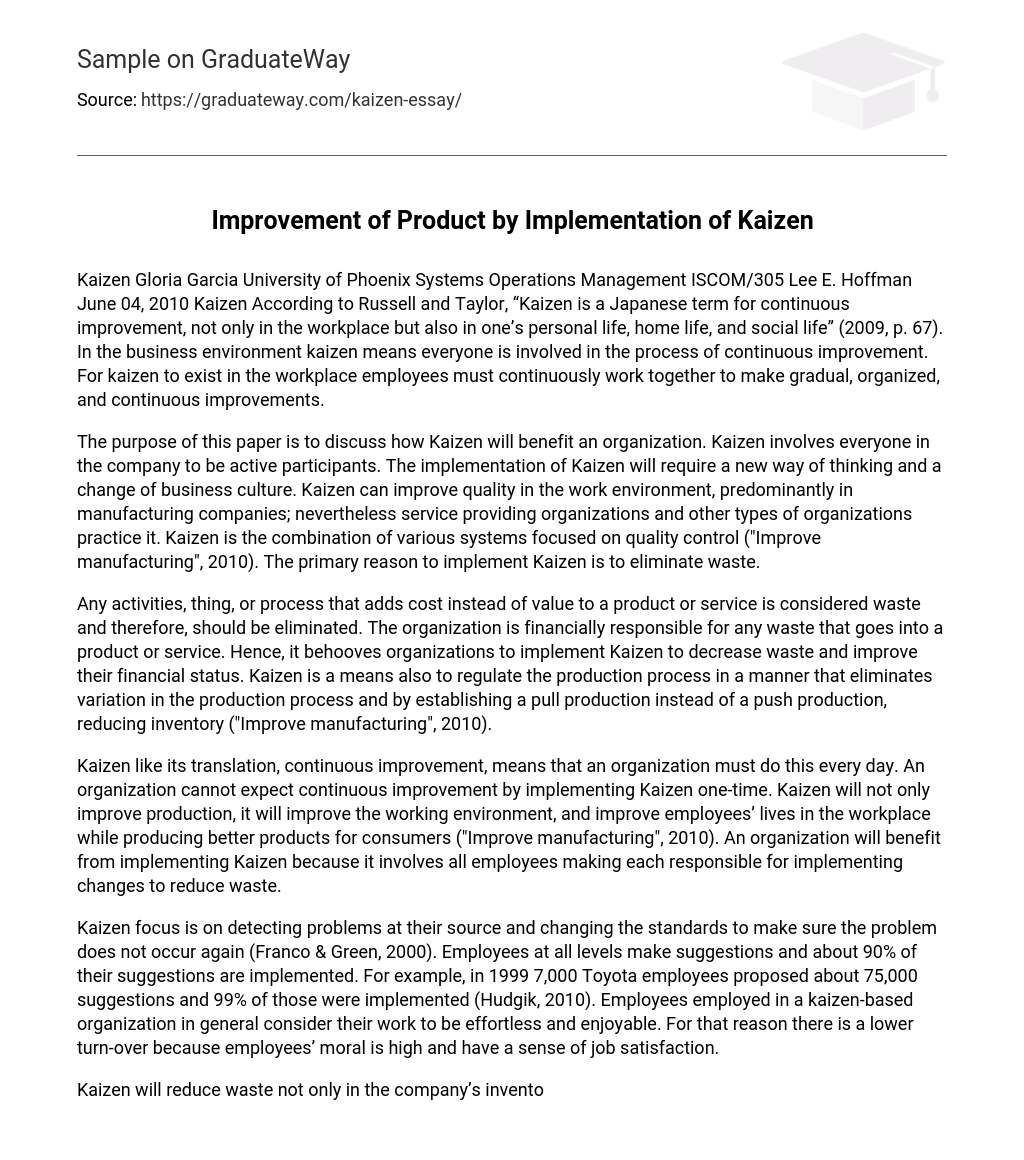According to Russell and Taylor (2009, p. 67), Kaizen refers to the constant improvement in various aspects of life, including work, personal life, home life, and social life. In business, kaizen signifies the involvement of all individuals in the ongoing process of improvement. To establish kaizen in the workplace, employees must collaboratively strive for gradual, organized, and uninterrupted enhancements.
The objective of this document is to explore the advantages that an organization can gain from implementing Kaizen. Kaizen requires the active participation of all members within the company. The adoption of Kaizen necessitates a shift in mindset and a transformation of the existing business culture. Kaizen can enhance the quality of the work environment, particularly in manufacturing companies. However, service-based organizations and other types of establishments also implement Kaizen. Kaizen integrates different quality control systems (“Improve manufacturing,” 2010). The primary motive behind adopting Kaizen is to eradicate inefficiency.
Any activities, thing, or process that adds cost instead of value to a product or service is seen as waste and should be eliminated. The organization is responsible for any waste that goes into a product or service. Therefore, it is in the best interest of organizations to implement Kaizen to reduce waste and improve their financial situation. Kaizen also serves as a way to regulate the production process, eliminating variation and establishing a pull production instead of a push production, which in turn reduces inventory (source: “Improve manufacturing”, 2010).
Kaizen, which translates to continuous improvement, requires organizations to engage in this process daily. By implementing Kaizen only once, an organization cannot expect to achieve continuous improvement. However, Kaizen offers benefits beyond just enhancing production. It also improves the working environment and the lives of employees within the workplace. Ultimately, this leads to the creation of better products for consumers (“Improve manufacturing”, 2010). By involving all employees, Kaizen ensures that everyone takes responsibility for implementing changes aimed at reducing waste.
Kaizen focuses on identifying problems at their root causes and changing the standards to prevent the recurrence of these problems (Franco & Green, 2000). Employees at all levels are encouraged to make suggestions, and around 90% of these suggestions are put into action. For instance, in 1999, approximately 7,000 Toyota employees proposed roughly 75,000 suggestions, and almost all of them were implemented (Hudgik, 2010). In general, employees working in a kaizen-oriented organization perceive their work as effortless and enjoyable. Consequently, turnover rates are lower due to high employee morale and job satisfaction.
Kaizen not only reduces waste in the company’s inventory but also in lagging times, shipping, employee skills, surplus in production, superfluous quality, and processes. Additionally, Kaizen improves the use of space, product quality, capital use, communication, production capacity, and employee retention. Kaizen starts with small improvements that gradually address larger problems by consistently reducing waste and enhancing processes (Hudgik, 2010).
Fleetwood RV’s plant 77 in Chico, California demonstrates the importance of implementing Kaizen. In 1997, the company’s production had stabilized and manufacturing had plateaued. However, upon discovering Kaizen, management recognized its potential for company growth. Once consultants agreed that Kaizen could be effective, the company proceeded with its implementation. Senior management aligned their objectives with the newly developed policy and skills. A team was formed to identify areas of waste through brainstorming.
In July 1998, Plant 77 achieved significant reductions in cycle times, work-in-progress, labor hours, and floor space waste (Franco & Green, 2000, para. 10). In December 1999, Plant 77 organized its inaugural public Kaizen event, during which 48 participants collaborated in various company areas to detect waste. Plant 77 currently conducts two private Kaizen events per month to identify waste in all areas. A primary waste concern initially addressed was the utilization of eight-foot lengths of lumber, whereas a seven-foot length was sufficient for most projects.
The supplier has made a change from using a 16-foot length to a 14-foot length, resulting in cost savings for Fleetwood. Furthermore, the company has reduced the amount of lumber brought in, leading to a 29% decrease in required floor space for storage. In an effort to address concerns about space and employee safety, Fleetwood has replaced large heavy jigs with fiberglass skin jigs for constructing pine RV frames. This change has not only reduced the space needed for storage, but also decreased the occurrence of employee injuries, as the new jigs are lighter and easier to handle (Franco & Green, 2000).
One success story in implementing Kaizen is Fleetwood. Sony also had a positive experience, increasing their production drastically in just over a year. ACP Manufacturing LLC saw improvements in safety and productivity as well. The key to Kaizen’s success is getting everyone in the company involved and committed to the process. Kaizen is a constant and continuous improvement approach.
Employees are encouraged and valued for their suggestions. Kaizen encompasses five elements which include teamwork, personal discipline, improved morale, quality circles, and suggestions for improvement. According to the “Ultimate Resource” (2006), the kaizen process employs various techniques such as small-group problem-solving, suggestion schemes, statistical techniques, brainstorming, and work study. The goal of kaizen is to identify and reduce waste in companies, thereby improving the company’s financial status.
References
- Franco, V. R. , & Green, R. (2000). Graphic products: Kaizen at Fleetwood. . Retrieved from http://www. graphicproducts. com/tutorials/kaizen/kaizen-at-fleetwood. html
- Franks, A. (2006). Application of lean manufacturing in a ductile iron casting facility. Ductile. org/Magazine. Retrieved from http://www. ductile. org/Magazine/2006_3/DIS%20Fall%2006%20
- Franks. pdf How to use kaizen to improve manufacturing. (2010). BusinessKnowledgeSoruce. com: Knowledge to help you build your business. Retrieved from http://www. businessknowledgesource. com/manufacturing/how_to_use_kaizen_to_imp





